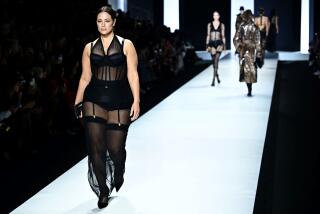Beauty Is Smaller Than We Think
- Share via
A couple of months ago, I stood before the mirror, checking my peach knit tunic for stains. I was surprised at my pudgy reflection, because I remembered looking the same way when I’d last worn the top many months earlier.
This time, though, I was six months pregnant.
“How pathetic!” I thought. “I feel as though my stomach sticks out this far all the time!”
This was a powerful moment for me, proof positive of what I’ve long suspected--that I suffer from serious perceptual problems when it comes to judging my size. And, until recently, I’ve had no clue how others see me.
Eventually, though, a woman in my condition reaches a point at which people feel they must address her dimensions in awe-struck tones.
“You must be big as a house by now,” a friend said on the phone the other day.
“No,” I replied, determined to outdo him. “More like a medium-sized apartment complex.”
Why do I feel compelled to engage in this ridiculous self-deprecation?
The fact is, at eight months pregnant, I’m no bigger than a small studio apartment.
Most of us are hopelessly at sea when it comes to evaluating how we look.
My friend Kathy and I take turns pointing out women with our “nightmare bodies,” the shapes we are sure we will acquire given enough time and Ben & Jerry’s. Hers is a tiny-shouldered, huge-bottomed pear. Mine is a giant round blob on toothpicks.
But, as it turns out, most of us are also adrift when we try to guess what others find attractive.
Recently, two Florida psychologists devised a study that examined male and female ideals about body image, using breast size for women and chest size for men. The results, published in the current Journal of Social Behavior and Personality, show that neither sex has a correct perception of the other’s ideal. Women believe that men prefer larger breasts than men actually prefer. And men believe women prefer larger pectorals than women actually prefer.
The test subjects were undergraduates at the University of South Florida. Looking at line drawings of women and men with increasing breast and chest measurements, they were asked first to rate their own size. Next, they were asked to identify their ideal size, what size they thought their own sex preferred and what size they thought the opposite sex preferred.
Everyone thought everyone else liked something bigger.
And everyone thought their own size was smaller than everyone else’s ideal.
The researchers, J. Kevin Thompson and Stacey Tantleff, also asked their subjects to ascribe attributes to people with various breast and chest sizes.
Both men and women associated “confident” and “popular” with larger sizes, while small sizes were paired with “lonely” and “depressed.”
Thompson and Tantleff say this means that people contemplating plastic surgery--and experts suggest that half of such patients may soon be men--should reconsider if they are driven by what they think the opposite sex will prefer.
I wonder if that will ever be possible. What we find attractive is so often a function of what we have been conditioned to think attractive. How do you decide what is your own spontaneous idea of beauty and what is an externally imposed standard? Expose me long enough to something I think ugly--deep red lipstick, Lyle Lovett, Los Angeles--and I may end up becoming desperately attracted.
Recently, on one of those day-time talk shows, I saw a guy with a store-bought chest. He was nice looking but apparently distraught that all his work at the local fitness emporium was failing to manifest itself in his pectorals. So he got implants. Naturally, the audience goaded him into taking off his shirt. His pecs were very nice and very well-defined, though not too large.
“I loved him before,” said his girlfriend. “And I love him now.”
That’s really the point, isn’t it? Accepting ourselves and others for what they are and how they look.
But it’s probably too much to expect people to be happy with themselves. The social pressures are overwhelming, and almost no one in real life looks like the people on television or in the fashion magazines.
I stood in front of the mirror again last week, pretending I was posing for a Vanity Fair cover like the one Demi Moore did when she was about eight months pregnant. No matter how I turned or preened, that ripe, sensuous look eluded me.
As I stared at that vast expanse of skin--mine, all of it!--all I could think was, “No, not a house, not even a studio apartment. More like the Goodyear blimp.”



